by
J.F. Caddy
Marine Resources Service
FAO Fisheries Department
INTRODUCTION
It is a general principle of legislation and managerial action that, if a desired result can be obtained directly, it is more appropriate to frame the laws, guidelines or regulations in such a way that this objective is clear to all, rather than to achieve it by indirect means. From this viewpoint, the most obvious approaches to regulating the harvesting of a stock are either to control the level of catches or landings or to control access to the resource. These more or less direct approaches have been extensively discussed elsewhere and a fairly large body of experience has accumulated in developed countries suggesting that, although these two approaches are direct, they are also information hungry and require a large civil service for the day-to-day operations involved in collS., 1970 The raft fishee necessary information and in enforcing the regulations.
Bearing in mind that the ultimate control on harvesting intensity is to manipulate the level of fishing mortality exerted, it is worth asking what other types of regulatory measures can be considered that affect this important variable.
The following paper presents some of the other possible types of regulation that can indirectly affect fishing mortality on the stock, and inevitably these include many of those regulatory measures available to the manager which are not often thought of in the context of effort control. Deliberately excluded here are those socio-economic impacts that drive the fisheries system which, again, are treated elsewhere. Indirect measures can sometimes present rather effective if less quantifiable alternatives, alone or in conjunction with other measures, for controlling the fisheries system without enormous expenditures. A list of such possible measures, with their main advantages and drawbacks, is given in the following document and is intended principally as a basis for more detailed discussion during the course of the Consultation.
INDIRECT METHODS OF CONTROLING FISHING MORTALITY
Seasonal closures of fixed duration
Various reasons have been proposed for closing fisheries for limited or longer periods of the year. All of these share in common the objective of protecting the stock from exploitation during at least part of its life history or during particular seasons of high vulnerability and may enclose part or all of the range of the resource in question. Two separate types of motives may be recognized for such closures:
1. A non-specific one: namely to maintain exploitation rates at reasonable levels if fishing effort is essentially uncontrollable
Problems: The main difficulty is that the closed season may grow to occupy a significant part of the year, if the stock remains vulnerable and high economic returns are realized or if poor alternatives to exploitation of this resource exist. The other problem is in deciding on the duration of the season, particularly if unnoticed increases in efficiency of harvesting can occur. This may lead to calls for institutionalizing inefficient methods of harvesting, which is then likely to require greater enforcement activity unless more specific entry limitations are brought in. We may conclude that this type of measure alone is unlikely to be effective in protecting the stock or maintaining a given stock size.
Advantages: In some senses, enforcement of closures is simpler than other regulations, particularly if there are only limited points of landing; however, the rather deceptive simplicity of the legislative process may obscure problems of enforcement if the resource in question is available from other fisheries that are open at this time. In this case, possession of the catch or the fishing gear may not be an adequate basis for prosecution. This type of enforcement measure may therefore be complicated if a vigorous black market exists, especially if the product is imported legally from elsewhere during the closed season (e.g. the Caribbean spiny lobster fisheries - FAO, 1982). Seasonal closures may also lead to wide fluctuations in price and discontinuities of supply, with again the development of conditions conducive to black markets for illegal fish (example: the Canadian East Coast lobster fishery - De Wolf, 1974).
(N.B. One possible variant of fisheries closures is an institutionalized turn-around time, fixed number of trips per year or enforced layout (e.g. Crutchfield and Zellner, 1962). This type of measure, although rather weak in its potential impact, has some advantages where mechanisms already exist (e.g. customs clearance) to monitor entry and exit from port. Another variant used (particularly in certain shellfish fisheries, e.g. the Brittany scallop fishery) is a limited number of fishing hours per day in a day fishery. This appears to be taking the concept of institutionalizing economic inefficiency to an ultimate point, and also poses some obvious enforcement problems.)
2. Closures to protect life history stages, or prevent fishing during particular seasons of the year
A number of different motives for closures come into play here, of which the following is probably an incomplete list:
(a) Closures to protect the stock during periods of special vulnerability
Such vulnerable components of the population may be pre-spawning aggregations, during spawning or seasonal migrations through areas of high vulnerability, i.e. so-called “gantlet” fisheries (Paulik and Greenaugh, 1966; Caddy, 1982). This type of closure can apply to all types of gear or (as with fixed gear during migration of anadromous fish) just to the more efficient or “destructive” type of gear.
Problems: In many fisheries, particularly for those where spawning is inshore, harvesting during the spawning season is often the most cost-effective procedure and application of such a regulation may prevent particular products (e.g. eggs or roe) from being harvested. Weighed against this should be the effectiveness of determining a preset “escapement” of spawners to replenish the stock. One approach to this problem may be to allow fishing only on certain days of the week, if this can be done without interrupting spawning or damaging the deposited eggs.
(b) Closures during periods of poor market prices or when condition of the fish is poor
For species where the level of seasonal landings strongly dictates market prices or where the species is less valuable because it is in poorer marketable condition at certain times of year, this type of regulation, if applied judiciously, can do a great deal to improve economic returns for the same landed weight.
Examples: Illustrative of the first case is the Southwest Nova Scotia lobster fishery where the winter open season coincides with low abundance and high prices for this product on the North American market, since most of the landings elsewhere on the east coast of North America are taken during summer months of high vulnerability to trap fishing in the New England lobster fishery that effectively dominates the market (De Wolf, 1974). This is also an example of the second category of measures above, since winter seasons for northern lobster coincide with optimal quality and handling conditions, with few of the soft-shelled (post-moult) specimens occurring that are so common in summer.
(c) Closures because of seasonal toxicity or unpalatability of the product
Seasonal closures, e.g. of shellfish fisheries due to paralytic shellfish poisoning (PSP) or because of high coliform counts, may in some parts of the world have an indirect impact in assisting conservation, although this is unlikely to be more than marginal in most cases.
General comments on (a) to (c): It has largely proved impossible to control exploitation effectively by this type of mechanism even though in most cases enforcement of seasonal closures is easier than, for example, quota management.
Seasonal closures of variable duration
Theoretically, varying the duration of a fishery may under certain conditions provide some control of the level of removals or at least the minimum biomass to be left at the end of the season for reproduction of the stock in the following years. (A distinction is made here between the situation where the season is preset but its duration may be varied from year to year, depending on the number of units in the fishery, and a situation where the season length is not set in advance but may be closed at such time as a particular set of criteria are met.)
Two approaches to stock assessment underlie this approach: the Leslie-Delury methods of estimation (Ricker, 1975); both of which require that the stock remains constantly vulnerable to fishing during a given season without excessive immigration or emigration (Fig. 1).
Both models have been used to estimate fish population size but can be modified to provide the basis for a regulatory mechanism, if the above criteria (no immigration/emigration and constant catchability during the season) are approximately satisfied and if catch rate and either total landings or total days fished can be monitored. Ideal circumstances for applying the approach are fisheries on relatively sedentary (e.g. shellfish) stocks, from one or two main ports of landing where complete statistics can be collected.
Various pre-agreed approaches can be used to decide on the cut-off point for the end of the season: this can be determined when the weekly or bi-weekly average catch rate falls below a given minimum pre-agreed with the fishermen. This minimum can either correspond to the predetermined economic break-even point for the fleet or be based on a desire to leave an adequate minimum biomass for reproduction. This approach has the advantage that low catch rates at the end of the season provide less incentive for infringement.
Problems: The past history of the seasonal evolution of catch rates must indicate that wild fluctuations in the availability and mean catch rate do not occur. The method also requires an efficient and timely reporting and summarization of catch rate data, and issuance of a closure notice well enough in advance to allow planning of fishing at least one week ahead. Very good communiction with fishermen is presupposed, plus strong input of fishermen to the management process.
A variation of this approach has been suggested in cases (e.g. the Red Sea fishery for cuttlefish - Sanders, 1981) where, in past seasons, a good correlation has been found between early season catch rate and total landings during the season. Using this approach, if a steady decline in average catch rates regularly occurred in the past, an in-season quota may be calculated after the first few weeks that will effectively control the effort exerted and duration of the fishery to fit whatever objectives are set by management and industry.
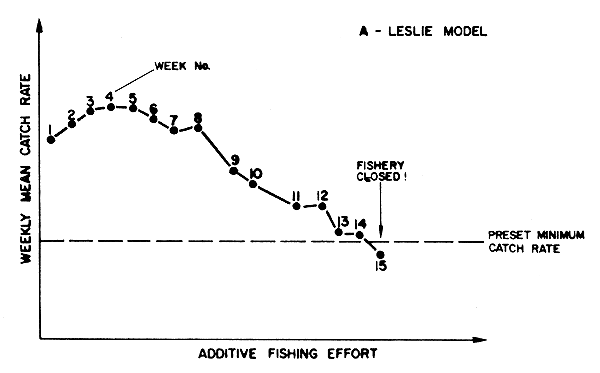
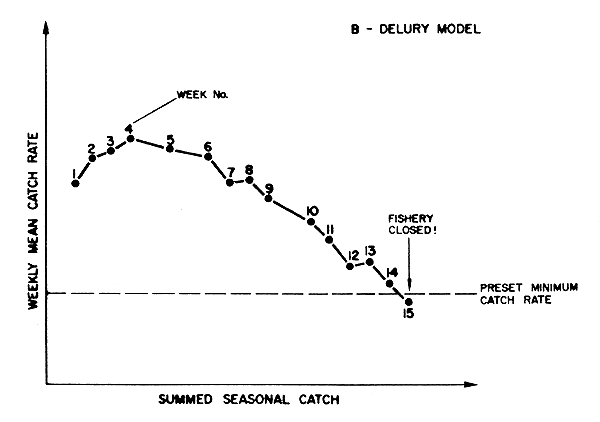
Figure 1
Two approaches to controlling effort indirectly by a variable season duration
Closed areas
In contradistinction to the preceding category of management measures, we refer here to permanent closures of small fractions of the range of a resource.
This may include:
Areas of continued high vulnerability of life history stages or areas that it is not economically or biologically desirable to harvest for species where the breeding and hatching season is protracted. A possibility here might be closure of some coastal lagoons which are nursery areas for shrimp or marine fish or beaches which are nesting areas for, e.g. marine turtles.
Parks or reserves intended to protect certain limited fractions of the population in areas which are heavily fished or otherwise liable to extinction, e.g. the “parcs” set aside for the “common” lobster, Homarus vulgaris, along the French coast, and certain coral reef areas now forming underwater reserves.
Advantages and problems: Although this type of regulatory measure has certain advantages in that, once instituted, it requires little subsequent attention from a legislative point of view, its effectiveness in ensuring survival and re-seeding of adjacent depleted areas is often difficult to evaluate. Problems of enforcement may also be expensive and, even if a majority of fishermen are in agreement with the measure, the possibility of infringements by a few individuals will need to be monitored.
The effectiveness of this measure as a source of replenishment for the population elsewhere in its range will depend on the area chosen, its size and whether it protects some or all of the life history stages of the population. Evidently, if the area is too small to contain a viable breeding population, the value of such parks or refuges must be questioned. In the case of species with pelagic larvae, the refuge should be “upstream” from commercial areas with respect to prevailing currents and should coincide with the known distributional range of mature individuals.
Refugia
This term has come to have rather wider connotations than simply a limited area where harvesting is forbidden (see Anthony and Caddy, 1980). A refugium may be any set of circumstances, geographic of otherwise, that ensures that a certain (limited) proportion of the population survives to breed. Some obvious examples are as follows:
Limited occurrences of locally poisonous (e.g. ciguatoxic) fish have become known to fishermen, in several tropical and sub-tropical areas of the globe where this type of phenomenon occurs, and result in normally palatable fish (e.g. groupers and snappers) being unsafe for human consumption (Olsen et al., 1983). The low fishing pressure exerted locally in these areas may preserve breeding populations that will provide non-toxic recruits to adjacent heavily-fished “safe” areas.
Sub-tidal populations of valuable resources (e.g. abalone, lobster) may be fished to low levels in absence of effective regulations but the marginal fringes of such populations (or areas where, because of e.g. strong currents, harvesting is limited) may constitute refugia for the species.
A similar situation may prevail in trawl fisheries for species where a proportion of the stock occupying untrawlable areas constitutes a refugium for the species.
More subtle types of refugia may be provided by fishing methods. For example, the maximum diameter of trap aperture for lobster pots or fish traps constitutes a refugium for those individuals that survive to a size too large to enter a trap. Alternatively, the limited depth of action or range of fishing vessels can constitute a refugium if only part of the range of the stock is covered.
A special category of regulations relevant here are the “maximum size” regulations that are in effect for lobster in Maine, USA, and the “berried” lobster law in Canada that prohibits possession of large females bearing eggs. Similar maximum size regulations have been proposed for sturgeon where large females contribute a great proportion of the mature eggs.
Setting fishing seasons, during seasons when weather conditions are too rough to fish in certain parts of the population range, is in effect providing a refugium.
Comment : This type of management measure previously was achieved incidentally, and was very effective in the early stages of fisheries (especially primitive artisanal fisheries) that initially only exploited a fringe of a population residing in generally deeper waters, but is rarer now that fishing boats and gear are more efficient and can fish at greater depth. Theoretically, formulating regulations to ensure fixed escapement would be possible if a certain proportion of the total range of the stock were left unfished, as with the concept of periodically fallow land in agricultural crop-rotation practices. One possible indirect benefit of fisheries closing zones or EEZ boundaries would result if regulations were formulated to ensure that areas within a limited distance of a maritime boundary were not fished, as in fact happens nowadays close to underwater pipelines or oil rigs. With growing use of the marine environment, and a greater awareness of property rights and their boundaries, we may suspect that the creation of such marginal refugia may grow in importance, even though it is very difficult to consider them as a principal method of management.
Coastal belts
The concept of a coastal fringe reserved for inshore or artisanal boats and closed to large industrial (e.g. trawler) fleets has been put forward in a number of forms in several countries, based either on a minimum distance from shore or minimum depth of operation of the offshore fleet. Maximum depth or distance from shore is rarely specified for the inshore fleet component, reflecting a socio-political decision to reserve certain benefits for coastal communities and especially artisanal fishermen.
One factor enhancing the attractiveness of this type of regulation for many tropical nearshore fisheries is the relatively narrow depth range of the shallow shelf supporting fisheries with a high productivity. This makes it necessary for trawlers to fish closer inshore than in temperate regions, which again leads to the kind of conflicts that promote this kind of regulation.
Although the motive for this type of regulation is usually past overfishing of nearshore areas by industrial vessels, its immediate objective is often the reduction of gear and vessel conflicts between different national fleets. Initially, this measure will have an indirect impact on the total fishing mortality exerted on nearshore stocks, but this will not necessarily persist unless supplemented by other regulations governing individual access or limiting levels of removals.
Advantages and problems : Although there is one clear political advantage to this type of action, in that there are usually larger numbers of individuals involved in the artisanal fishery than in the industrial one, evaluating the impact of this type of regulation is not so easy. For example, it must be considered whether or not the main resource is migratory and can still be fished offshore. If so, under certain circumstances, the offshore fleet may continue to control catch rates of the inshore fleet if specific offshore allocations are not given. Conversely, if artisanal fleets exploit such shared stocks on the nursery grounds (e.g. for penaeid shrimp), they may control recruitment of adults to the offshore grounds where they could otherwise have been caught at sizes providing a greater economic yield. Unless enforcement is left to the fishermen, this type of measure doubles the length of maritime boundaries that need patrolling (i.e. the boundary of the coastal belt is added to the EEZ boundaries).
Size limits and effort control
It has been noted that regulations that restrict the size of the fish caught directly, or via regulations on the minimum mesh size of the gear, act indirectly to restrict the fishing effort exerted on certain components of the stock, particularly on the younger and smaller fish. This is especially obvious for species such as squid and penaeid shrimp which usually have a population consisting of one year class and where an increase in mesh size in effects acts as a closure, thus delaying onset of the fishery. Also, for multi-age stocks, areas of congregation of schools of young fish may be protected from heavy fishing by appropriate mesh sizes or the fishery postponed, assuming of course that the stock has already been recruited to the fishing ground at this time. We can therefore conclude that size limits and other regulations do act as indirect controllers of the fishing mortality, as well as modulating the impact of the fishing effort exerted. We may, consequently, ask the question:
Under what circumstances is a minimum size regulation a substitute for controlling fishing effort?
Judging from experience in the North Atlantic Fisheries Commissions, ICNAF and NEAFC, where for many years mesh size regulations were the only ones “on the books”, we can perhaps conclude that this type of measure alone does not achieve the necessary impact since, with unlimited entry, it still managed to result in decimation of some of the fisheries in question. It would be fairer however to refer to Fig. 2, showing a yield per recruit isopleth for a typical North Sea plaice stock, before attempting to answer the above question. In this figure, yield per recruit is shown by the individual “onion leafs” on a graph in which the age at first capture is the vertical, and the fishing intensity mortality rate the horizontal axis.
The maximum yield per recruit for a given size at first capture is shown by the dotted line A-A' and the maximum yield per recruit for a given level of effort by dotted line B-B' and in both cases this shows that, as a fishery is more intensively fished, the appropriate size limit needed to maximize yield from a given number of recruits must go up. Perhaps it was the failure to recognize this and adjust for it, rather than the failure of size limits in an absolute sense, that led to the situations described above. Certainly mesh size regulations alone, unless set rather too large to be practical or modified continually, will not guarantee conservation without some entry restrictions.
Under what circumstances of size at first capture then can we consider that a stock is particularly vulnerable to overfishing? Here we should look at the age of maturity and reproduction. Suppose, as in Fig. 2, a species is first fished at 8 years of age (t'c = 8), but one stock A matures only at age 11, and another C at age 5; clearly stock A is more vulnerable to overfishing before spawning than is stock C which matures and breeds three years before being fished. This is obviously a hypothetical case, since the growth and mortality rates for the two stocks would be sufficiently different in this case that the yield isopleth itself would change. It is simply intended to illustrate that the need for effort control is most pressing when the stock is very vulnerable to fishing as juveniles and where mesh size regulations to protect them are not feasible.
Regulations based on mean size of fish landed or on maximum count per landed weight
This type of regulation is a feasible alternative to mesh size and absolute minimum size regulations, and may be considered as having an indirect impact on effort exerted. It may be applied under circumstances such that:
Large numbers of small individuals are captured by unselective gear (e.g. dredges), making an absolute minimum size limit unenforceable, and where mechanical or manual sorting of the catch is unfeasible.
Although the gear is unselective, the species in question is either fairly well segregated by size in areas known to the fishermen or survival of discarded small individuals at sea is known to be high (as, e.g. with shellfish populations).
Advantages and drawbacks : This type of regulatory measure is designed, as with mesh regulations and minimum size limits described earlier, to increase the mean age of capture of the species and protect new recruits from premature exploitation. In some circumstances, it can also act as an indirect measure of effort control. This latter effect comes into play as the mean size of fishable individuals in the population declines towards the legislated minimum mean size, when the effort needed to achieve a given increment in landings goes up exponentially, since more and more time and effort has to be spent culling out small individuals or looking for increasingly scarce larger individuals to bring up the mean size of the catch. This kind of regulation may, in this way, promote the fishing of marginal areas where large individuals often occur at low density, and thus has an impact in reducing effort on areas of abundant new recruits.
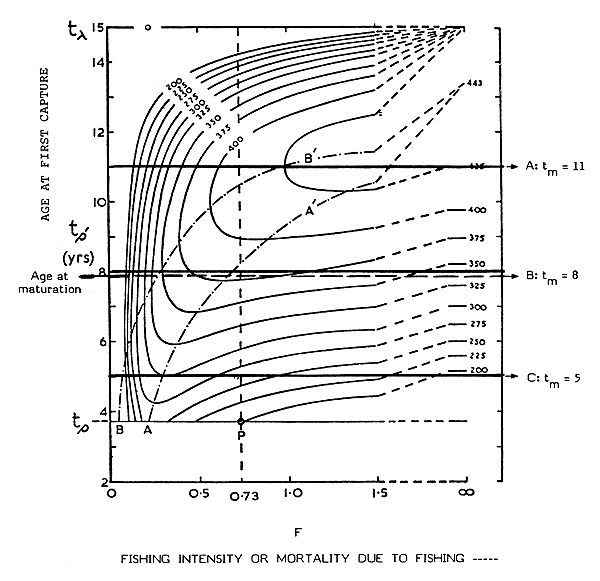
Figure 2 Yield isopleth showing combined effect of age at first capture (tρ) and fishing intensity (F), on yield per recruit (from Beverton and Holt, 1956), showing a postulated age at recruitment of 8 years and 3 equally hypothetical ages at female maturity of 5, 8 and 11 years.
Since, unlike minimum size limits, some smaller individuals are landed legally, this approach is less efficient from a yield per recruit point of view, but may have some economic advantages where different size grades are needed for specific market sectors.
Specific contraindications to the use of this approach prevail where excessive discarding promotes wastage and high incidental death rates. Some difficulties may be encountered also if tolerances for infringement of the regulation are not preset, or a proper sampling procedure set up for inspection, and we can note here that the sampling procedure used may have a significant impact on the “tightness” and fairness with which the regulation is enforced.
In general, we may note that mean size in some circumstances is an index of fishing intensity or mortality and can be used as a control variable to follow changes in fishing intensity if effort is not readily measurable. In fact recent developments of production model theory (Csirke and Caddy, in press) would permit a regulatory scheme of this kind in the absence of collection of effort data.
By-catch regulations
Under certain circumstances, where a fishery is aimed at a high value species and where a significant over-investment in vessels and fleet capacity prevails (e.g. many industrial shrimp fisheries), regulations requiring that a given tonnage or proportion of hold space be devoted to bringing back edible by-catch species, will have some impact in either discouraging excessive further investment in this fishery, increasing the proportion of fishing time devoted to culling the catch, or reducing the time spent fishing specifically for the target species. This type of regulation will however be largely determined by other factors, such as the need to avoid wastage of protein.
INFORMATION NEEDS AND THE DECISION PROCESS IN FISHERIES MANAGEMENT
Fisheries managers utilize a great variety of types of information in their work, and usually have to rely on incomplete data before making decisions that will be crucial to the livelihoods of many people. As such, data collection, or a statistical service plays a key role in a fisheries department, both in relation to assessing the state of the resource and in relation to monitoring markets and available plants and vessels in the fishery. In consequence, fisheries managers have a vested interest in improving their data sources but (and this must apply particularly to managers in developing countries) they must look for data sources that are within the budget and manpower allocation available to them, i.e. the most effective and reliable sources of data (and of course the cheapest and most effective management measures they support), since these will be of the greatest utility.
Types of data
In general, at least for day-to-day decision-making, managers tend to rely most immediately on their own observations and on the opinions of trusted colleagues and knowledgeable persons in the industry. For quantitative information related for example to the level of landings from the fishery, market conditions and prices, however, an objective system of collecting data is advisable. In this situation there are at least two separate types of information which we may call “extensive” and “intensive”. We may choose as examples of the former the total level of removals from the fishery or the total number of days fished by the fleet and, for the latter, the catch rate or the mean size of fish landed by a sample fleet. Although it is important for this second category of intensive indices that we know that the vessels sampled adequately represent the fleet and are not showing anomalous behaviour, we do not have to know the landings for all the boats throughout the year (which we would need for a recording system based on census techniques) nor do we have to enumerate all of the vessels fishing, as we would have to do in order to monitor landings by, for example, a sample survey.
It seems therefore that there are real advantages to measurement of intensive types of information and among these we can include catch rate, mean size and the species composition of the catch.
From each of these it may be possible to make reasonable deductions about the state of the resource and the intensity of fishing, without having complete knowledge of the removals, the fleet size or total number of days fished, and we can then take appropriate management action on this basis.
It is generally known that the mean size of a given species of fish landed decreases with the intensity of fishing, as does the catch rate. In some circumstances, a decline in the relative abundance of a given species on the market may also be a useful index of its relative abundance in the sea (Fig. 3). All of these indices have their cautionary sides, in that a low mean size may also be an index of unusually good recruitment and a high mean size may conversely indicate that recruitment failure has occured! Despite this, it would be relatively easy in many species to distinguish between low mean size due to high recruitment (in which case catch rate is likely to be above-average) and one which is due to a generally low abundance of all sizes and especially of large fish.
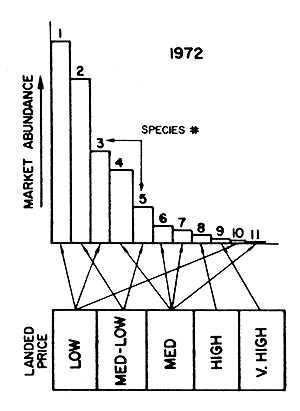 | 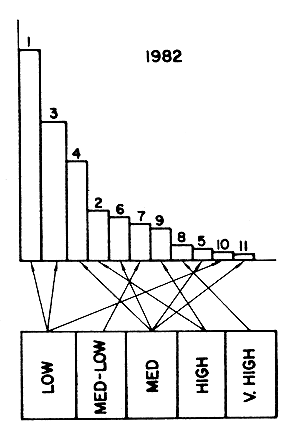 |
Figure 3 Illustrating how market surveys carried out in the same location in two successive periods may be used to point to possible problem areas for conservation. A decline in absolute abundance and ranked position in terms of abundance on the market for species 2 and 5, associated in this example with a movement “up-market” in terms of price, may give the manager reason to suspect a decline in abundance. If this is confirmed by further investigation, the stage may be set for some management action, controlling directly or indirectly the fishing mortality exerted on the stock.
Types of decisions
Three types of decisions may be distinguished in the managerial framework, the first two of which perhaps can be described most simply as corresponding to the mathematical signs = and or (less than or equal to, or greater than or equal to).
Attempting to manage for a given level of effort or removals, e.g. fopt, F0.1, MSY, MEY, etc., all require the manager to aim for a specific target, avoiding too high or too low values for the target variable. This is in effect aiming for equality (=) to some preset objective, and assumes that you know how to get there.
The second type of decision essentially is taken when the control variable (e.g. catch rate, mean size landed, individual earnings, market price, etc.) is either too low or too high, and involves deciding only on the direction in which these variables should be moved and not the precise position. If there are guidelines which tell you how to influence the direction of the control variable but not precisely the impact of the given manipulation, it is possible then to move in a series of discontinuous arbitrary steps in the direction recommended, pausing regularly to observe the effects of management actions on the control variable, without actually attempting to define the precise impact of any move in advance of the action. This type of decision-making appears more appropriate in basically uncertain situations such as fisheries than the former mode, since there is rarely good enough information to provide a precise “fix” on the present situation, and it is particularly relevent for assessing indirect impacts of regulations as discussed here.
The third type of decision is the null decision, which may be the most appropriate in many cases. It can however be very difficult to take a decision to do nothing to change the present situation, in view of pressure from interested parties. Generally speaking, although some events happen very rapidly in fisheries, the major decisions (e.g. on the level of fleet size appropriate to a given fishery) have long term impacts, perhaps in some cases almost as long term as the average life span of vessels and processing plants. As such, a decision not to increase for example the fleet size, until clear information is provided by the control variables that the present situation corresponds to underexploitation, may need to be sustained for periods of several years or more.
Multi-species extensions of indirect effort control
Most of the methods of effort control described so far in this document, as well as those that are considered in the other Panels of the Consultation, have implications for other than the “target” species in the catch. An example of this has already been given for a by-catch species but some more general comments are perhaps appropriate. The point being made in the following section is that, for very diverse multi-species fisheries, the proportion of a species in the catch may be as good an indication of the effect of fishing as mean size or catch rate.
First, the concept of a “target” species, which is the main species sought, may be rather irrelevant in the case of many tropical fisheries where a wide variety of species occur and where a variety of gear types operate, with often overlapping species retentions (e.g. Fig. 4). Perhaps it is then more appropriate to talk about “control” or “key” species that either occupy an important role as multi-species predators (e.g. groupers) or multi-predator preys (e.g. clupeids), or species which are taken in a wide mixture of gears (e.g. lane snappers or rainbow runners in Fig. 4). Looking at the impact of effort, or measuring mortality; on these key species may give some perspectives on what is happening to the whole community.
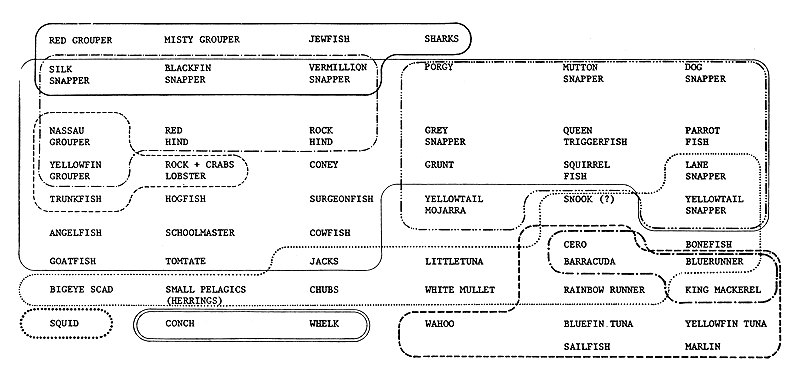
Fig.4 Species classified by availability to fishing gear (from Juhl 1975; Cole 1976) modified for BVI from information by Walters (pers. com. and others).
 | fish trap |  | longline |  | surface gillnet |  | trolling |
 | snapper reel |  | bottom gillnet |  | seine |  | jigging machine |
 | lobster trap |  | handcollecting |
Figure 4 Species classified by availability to fishing gear (from Juhl, 1975; Cole, 1976) modified for BVI from information by Walters (pers.comm.and others)
REFERENCES
Anthony, V.C. and J.C. Caddy (eds), 1979 Proceedings of the Canada-US Workshop on status of assessment science for NW Atlantic lobster (Homanus americanus) stocks. St. Andrews, N.B., 24–26 October 1978. Can.Fish.Rep.Fish.Aquat.Sci., (932):186 p.
Beverton, R.J.H. and S.J. Holt, 1957 On the dynamics of exploited fish populations. Fish.Invest.Minist. Agric.Fish.Food G.B.(2 Sea Fish.), 19:533 p.
Caddy, J.F., 1982 Some considerations relevant to the definition of shared stocks and their allocation between adjacent economic zones. FAO Fish.Circ., (749):40 p.
Crutchfield, J. and A. Zeller, 1962 Economic aspects of the Pacific halibut fishery. Fish.Ind.Res., 1(1): 173 p.
De Wolf, A.G., 1974 The lobster fishery of the maritime provinces: economic effects of regulations. Bull. Fish.Res.Board Can., (187):59 p.
FAO, 1982 Memorias del Grupo de Trabajo sobre la langosta. Llevado a cabo en San José, Costa Rica, Noviembre 1980. WECAF Rep., (36):277 p.
Olsen, D.A., D.W. Nellis and R.S. Wood, 1983 Ciguatera in the Eastern Caribbean. FAO Fish.Rep./FAO,Rapp.Pêches/FAO,Inf.Pesca, (278)Suppl:276–88
Paulik, G.J. and J.W. Greenough, Jr., 1966 Management analysis for a salmon resource system. In Systems analysis in ecology, edited by K.E.F. Watt. New York, Academic Press, pp.215-50
Ricker, W.E., 1975 Computation and interpretation of biological statistics of fish populations. Bull.Fish. Res.Board Can., (191):382 p.
Sanders, M.J., 1981 Revised stock assessment of the cuttlefish, Sepia pharaonis, taken off the coast of the People's Democratic Republic of Yemen. Rome, FAO/UNDP Project for Development of Fisheries of the Red Sea and Gulf of Aden. RAB/77/008:74 p.